It has been impossible to keep our travel account up to date since we moved on from Florence so this covers the last couple of days.
We left our eyrie high in the hills above Fiesole on Saturday morning and made our way along beautiful winding country roads through the warm Tuscan countryside, through little villages, pine woodlands and open rolling fields of bright flowers.
We were anxious as to how Modestine might cope with crossing the Appenines, the range of mountains running down the spine of Italy. (We assume the Pennines, running down the spine of England were so named by the Romans after their own mountains.) We chose our route carefully to avoid too much traffic. In the event we had the roads pretty much to ourselves and Modestine made no bones at all about the steep, twisting climb up through the bright green tree-clad mountains to the Passo della Faggeta, a mere 913 metres. We stopped several times on the way to gaze at the view and to fill our water bottles at a wayside fountain running with clean cold mountain water.
 Foothills of the Appenines
Foothills of the AppeninesThe top of the pass was dominated by a huge contingent of Italian bikers. They had all congregated there to admire each others rigs. They were indeed very impressive, each biker being dressed in leathers to match his bike. (There were also a couple of lady bikers too, Lesley-G.) Such vehicles are perfect for these narrow winding mountain roads but it is terrifying to round a bend in Modestine and see a bike hurtling towards you at an angle of 45 degrees! Some drivers too seem to take immense risks when overtaking on bends into the paths of oncoming vehicles.
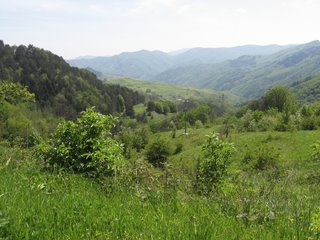 View from the Passo della Faggeta
View from the Passo della Faggeta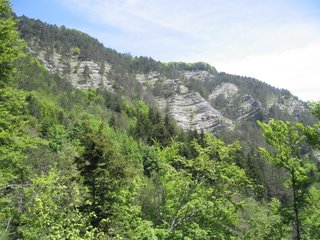 Monte la Faggeta
Monte la FaggetaFrom then on our way was down until we reached the flat lands of the Emiglia Romagna south of the Po. Below the level of the pine trees the descending road passed through steep, open countryside, the fields a bright mass of yellow, red and pink flowers where dandelions, poppies and clover each fought for supremacy. Here we found a spot to pull off the road and enjoy a coffee overlooking Italy's version of Heaven.
 Picnic spot in Tuscany
Picnic spot in Tuscany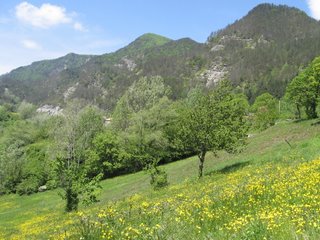 Picnic spot in Tuscany
Picnic spot in TuscanyWe continued our pleasant drive to the outskirts of Faenza, famed for the production of ceramics. Indeed the word faience as a kind of ceramic originates from this town. Having little idea what the roads would be like we parked on the edge and walked in. At first it seemed completely dead with nobody around, full of run-down palaces, empty streets and nowhere for us to restock our fridge.
We eventually discovered the cathedral and the main square with draped arcades fronting the governor's residence and the town hall. The pleasant shady terrace of a gelateria attracted us for a couple of coffees as we waited for the town to wake up after its lunchtime snooze. Ice cream eating seems to be Italy's favourite pastime! People would appear from side streets, cross the wide piazza to the café and return home with a huge cornet of melting pink or green ice cream!
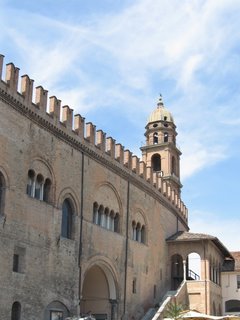 Governor's palace, Faenza
Governor's palace, Faenza Piazza del Popolo, Faenza
Piazza del Popolo, Faenza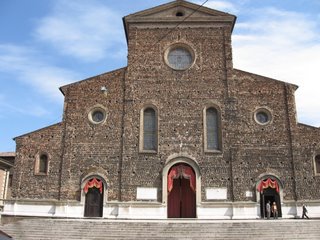 Unfinished façade of the Cathedral, Faenza
Unfinished façade of the Cathedral, Faenza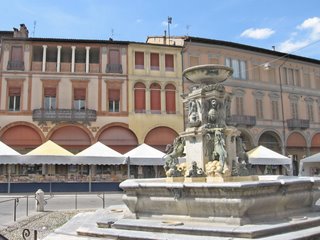 Fountain near the cathedral, Faenza
Fountain near the cathedral, FaenzaQuite suddenly the town came to life. Bicycles streamed across the square, people came out from their homes to stand and chat. Three police cars arrived and six blue-uniformed police ran up the cathedral steps to return, surrounding a rather sheepish looking and very wet young woman. After protecting the back seat of one of their vehicles they bundled her inside and exited the square in convoy! Had she been attempting to drown herself in the piscina we wondered?
The lady in the tourist information centre was really helpful, explaining in fluent English the best place to buy ceramics. Eventually she stopped long enough for us to explain we were more interested in purchasing vegetables at the moment! She also explained that the town did not have a campsite but there were farms where it was possible to stay, with facilities and gave us a couple of addresses.
We then got rather lost trying to find Modestine. After a very long walk in hot sunshine we finally discovered where we'd left her and also an out of town shopping centre well hidden away. Here we shopped for food and found access to the internet. Our passports were scanned, long forms completed and we were eventually allowed access. Apparently, according to the friendly owner of the internet shop it is a law that came in last September as an attempt to control terrorists. The same policy applied at campsites. They even need to know our date of birth and it all goes into a national computer. Our every move seems to be monitored here!
This evening though, we were to really mess-up their system! We became untraceable! Having left it too late to go further we sought out the two addresses we'd been given for spending the night. The first no longer existed and we were scared from searching for it by a massive, very angry dog, the second said it would cost us 15 euros without any facilities at all as the toilet and shower were in the house and we could not have access!
So we returned to the edge of town and found somewhere quiet for the night hoping we wouldn't be disturbed. In the event it turned out to be floodlit and a meeting place for youngsters from Faenza to gather on a Saturday night! It was really hot and close but we were scared to open windows for fear of attracting attention. Eventually it started to rain and everyone dispersed leaving us in peace for the rest of the night as the rain pounded down and the air became fresher and cooler.
Despite it all we slept well and woke refreshed on Sunday morning (14th May) to find the rain had ceased and we were in a lake of water. Anxious to be gone before anyone noticed us or the police found a blank space against the name Modestine on their national database, we set off around 7am. along wet, empty roads to Classe on the edge of Ravenna where we could see the large brick mass of Sant'Appolinare in Classe rising from the green fields.
Classis was once a busy port, founded by the Emperor Augustus, but now all that remains is this church, externally simple in style and consecrated in 549. Inside though, all the decorations are wonderful glass mosaics dating from the 6th and 7th centuries. In the arch behind the high altar is a pastoral scene with delicate shades of green, showing Christ with twelve lambs representing the apostles. To either side above the arcades are extremely lifelike portraits in medallions, and scattered around the church are early Christian stone sarcophagi, dating from the 5th to the 8th centuries. The range of styles is fascinating, from the earliest with the flowing draperies of classical statues and bas-reliefs, through the more primitive Ostrogothic decorations, emerging finally into stiffer, more Byzantine style.
 West front, Sant'Appolinare in Classe
West front, Sant'Appolinare in Classe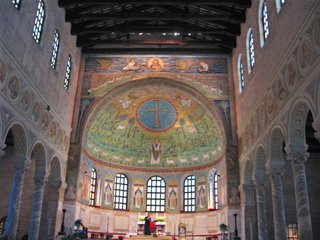 Mosaic of the Good Shepherd and the altar, Sant'Appolinare in Classe
Mosaic of the Good Shepherd and the altar, Sant'Appolinare in Classe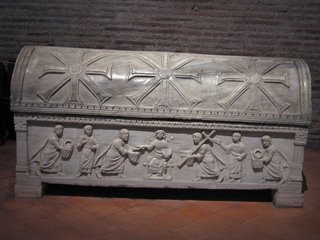 Sarcophagus in classic style, Sant'Appolinare in Classe
Sarcophagus in classic style, Sant'Appolinare in Classe Sarcophagus in Ostrogothic style, Sant'Appolinare in Classe
Sarcophagus in Ostrogothic style, Sant'Appolinare in Classe Sarcophagus in Byzantine style, Sant'Appolinare in Classe
Sarcophagus in Byzantine style, Sant'Appolinare in Classe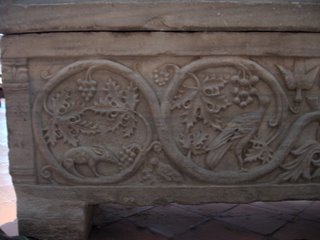 Detail from sarcophagus, Sant'Appolinare in Classe
Detail from sarcophagus, Sant'Appolinare in ClasseA priest was lighting candles on the altar, a young boy in red robes was poking his head around a door and pulling faces, groups of people who were clearly not tourists were starting to arrive. After an announcement the priest processed up to the altar followed by the four young acolytes, now transformed into angels, sprinkling the congregation with scented holy water and the service began. It was almost overwhelming to think of these same rituals being performed continuously within these same walls beneath these wonderful mosaics for 1500 years.
We left Modestine in the car park by the church and caught the little bus into the centre of Ravenna, about three miles to the north. It is a spacious town and its unadorned buildings do not announce themselves as obviously historical. The Piazza del Popolo is quite modest compared to the big squares in Florence. Although dating from as early as the 5th century many of its buildings look strangely modern from the exterior, being built in brick with shallow tile roofs. You have the feeling that although you are gazing at wonders of the early medieval world, you have seen something very similar constructed in the 1930s in Sidcup! The insides however are magnificent and as breath-taking as the exteriors are seemingly mundane.
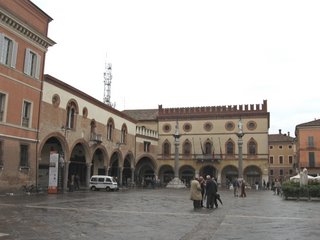 Piazza del Popolo, Ravenna
Piazza del Popolo, RavennaRavenna is famed for its splendid mosaics which apparently surpass anything to be seen elsewhere in Europe including Venice and Constantinople. Ravenna had succeeded Rome as the capital of the Western Roman Empire, but had been captured by the Ostrogoths in 476. In 540 it was captured in turn by the Byzantine Emperors. The mosaics executed throughout this period reflect many of these political changes in their evolving styles.
In the grounds of San Vitale stands the Mausoleum of Galla Placidia, the sister of the Emperor Honorius and it is probably the earliest intact building in Ravenna. A modest brick-built chapel dating from c.450, it contains mosaics on a vivid blue background which are purely classical in style, similar to illuminations in the earliest surviving vellum codices. Ian was delighted to find a depiction of a book cupboard, complete with the gospels placed flat on the shelves. As most interiors were photographed today without flash the detail is not always clear.
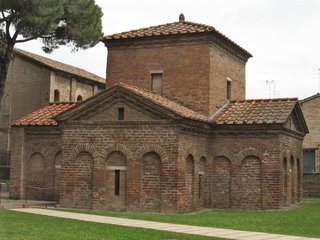 Mausoleum of Galla Placidia, Ravenna
Mausoleum of Galla Placidia, Ravenna San Lorenzo, his gridiron and book cupboard, Mausoleum of Galla Placidia, Ravenna
San Lorenzo, his gridiron and book cupboard, Mausoleum of Galla Placidia, RavennaBeside the 18th century Cathedral is the 5th century Neoni Baptistry, complete with a large font for baptism by total immersion. Here the mosaics were being restored, but they showed the same flowing draperies and vivid colours as in the mausoleum.
 Neoni Baptistry, Ravenna
Neoni Baptistry, Ravenna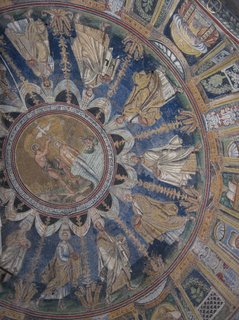 Mosaic depicting baptism of Christ with apostles, Neoni Baptistry, Ravenna
Mosaic depicting baptism of Christ with apostles, Neoni Baptistry, RavennaThe decorations in the church of Sant'Appolinare Nuovo, dating from the 6thcentury, are somewhat more rigid perhaps because of the processional theme of the mosaics above the arcades. The north side of the church was reserved for women and shows a procession of holy virgins leaving the town of Classis following the magi to Christ. The south side shows a procession of martyrs leaving the palace of Theodoric.
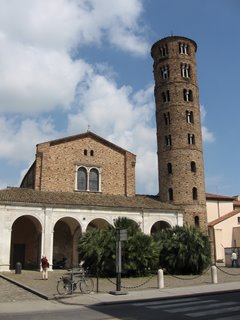 Sant'Appolinare Nuovo with campanile, Ravenna
Sant'Appolinare Nuovo with campanile, Ravenna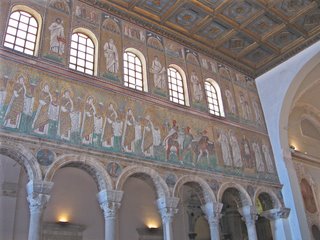 Procession of the virgins, Sant'Appolinare Nuovo, Ravenna
Procession of the virgins, Sant'Appolinare Nuovo, Ravenna Procession of the martyrs, Sant'Appolinare Nuovo, Ravenna
Procession of the martyrs, Sant'Appolinare Nuovo, Ravenna Port of Classis, Sant'Appolinare Nuovo, Ravenna
Port of Classis, Sant'Appolinare Nuovo, RavennaThe most splendid of the mosaics is to be found in the octagonal Byzantine church of San Vitale, consecrated in 547. In a riot of gold and vivid colours the Emperor Justinian, God's representative on earth, is surrounded by his court, each face showing individuality. They face a mosaic of the Empress Theodosia and richly adorned women of the court. These groups are stiffer, more formal, serving to underline their majesty. There are also scenes symbolising sacrifice which are more animated. The pillars, supporting the dome and the galleries originally reserved for women, are of split marble and the floor is tessellated. We spent some time attempting to figure out the labyrinth embedded in the designs of the floor.
 Exterior of San Vitale, Ravenna
Exterior of San Vitale, Ravenna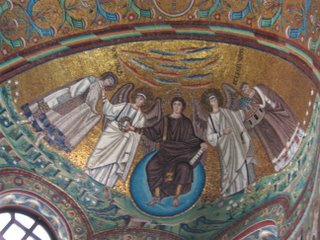 Christ in majesty, San Vitale, Ravenna
Christ in majesty, San Vitale, Ravenna Justinian and his court, San Vitale, Ravenna
Justinian and his court, San Vitale, Ravenna Theodosia and the ladies of the court, San Vitale, Ravenna
Theodosia and the ladies of the court, San Vitale, Ravenna Ceiling mosaic, San Vitale, Ravenna
Ceiling mosaic, San Vitale, Ravenna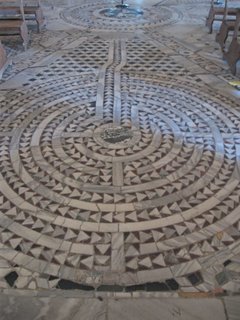 Marble labyrinth, San Vitale, Ravenna
Marble labyrinth, San Vitale, RavennaThe mosaics are constructed from small glass tesserae in a range of vivid colours. In all the churches they are as bright now as when they were originally placed there. This is in marked contrast to the 18th century frescoes in the cathedral and in the galleries of San Vitale where, because of the damp climate in this area of Italy, they are already faded and in serious need of restoration. The small Archiepiscopal Museum gave us the opportunity to examine fragments of early mosaics from vanished buildings in more detail.
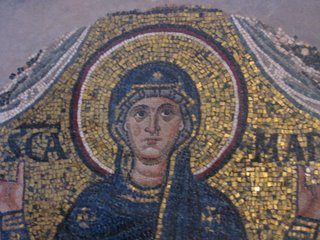 Mosaic fragment in Archiepiscopal Museum showing individual tesserae, Ravenna
Mosaic fragment in Archiepiscopal Museum showing individual tesserae, RavennaIn the Cathedral are temporarily displayed early marble tombs and inscriptions. Their labels tantalisingly gave no indication as to date. We found the 6th century ambos (stone pulpits) particularly unusual and attractive with their naïve animal decorations.
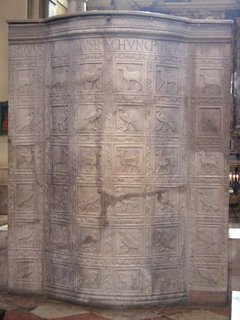 Stone pulpit in the Cathedral, Ravenna
Stone pulpit in the Cathedral, RavennaWhen in Florence we had seen the house of Dante. He was to be exiled from his native town and lived, worked and eventually died here in Ravenna. No visit to the city is finished without making a pilgrimage to his mausoleum, highly venerated by the people of the town who hold a festival for the poet annually.
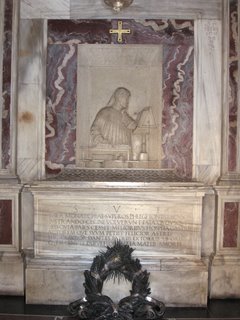 Dante's tomb, Ravenna
Dante's tomb, RavennaDuring the day our cultural experiences were punctuated by a break for a lunch of cannelloni and coffee cheerfully served in the courtyard of the caffè by the friendly happy lady who actually cooked it! It was both delicious and inexpensive.
Now though, it was time to catch the bus back to Classe and Modestine. From here we took the ring road round Ravenna following the signs for Venice. The roads were appalling with massive craters and potholes all along the two lane highway, as bad in the outer lane as in the inside one to which we restricted ourselves. We had thought Portugal must have the worst roads in Western Europe. These were at least their equal! Modestine is a heavy vehicle on her chassis so travelling for 30 kilometres along broken, cracked tarmac trying to avoid potholes and fast Italian drivers cutting in from the outside lane is very unpleasant. We still have another 125 kilometres of it before we reach Venice!
Turning off to the sea at Lido di Spina in search of a campsite we have ended up here in a massive holiday internment camp where our passports have been confiscated for police scrutiny and we have been specially tagged with blue wristbands so we can be scanned if we leave the complex for any reason! Why you may wish to do so the management cannot imagine, and in many ways they are right. It is clean, pleasant, friendly and inexpensive with cafes, a supermarket, beach shops, swimming pools and shady pine forests. This is where the Italians come for their summer holidays. There is private access to a huge clean sandy beach on the edge of the Adriatic – a first for us! Down the coast is the popular holiday destination of Rimini and across the water is Yugoslavia! There is a magic in realising we have travelled all this way in Modestine rather than being flown here by Easyjet! Today, as we sit beside Modestine under the shady umbrella pines the silence is broken only by the sound of wood pigeons and a jay hopping around us searching for fronds for its nest. Everyone else is down on the beach where they sit in regimented rows roasting in the sunshine, each with their own assigned beach chair, table and umbrella, all in matching green. Nearby is a waiter bringing cold drinks served from the campsite beach bar and restaurant. There is a row of matching beach huts for changing and cold fresh water showers for use before returning onto the campsite. The site is so large there are bicycles for hire just to get around it. Yesterday evening the site was busy with young men cycling lazily back from the showers, their tattood legs protruding from beneath their red towelling bathrobes which for some reason are worn with the hoods up. They looked just like Father Christmases on holiday!
Today we have decided to stay put on the site for a rest. Too much travelling and culture can be fatiguing and after a night by the roadside in Faenza and a busy day around Ravenna we felt we needed to build up our strength again for Venice. Time now for Hinge and Bracket to earn their keep as they save us eight euros a day each taking us around the campsite and possibly out to the nearby village in the hope of finding a police controlled internet shop – if we can get our passports back from the campsite first!
Before ending today's account Jill would like to acknowledge the enormous contribution of Ian in sorting out the historical sequence of events and styles in Ravenna for the above account. Incidentally, he has also managed to get us by admirably in Italian which he invents as he goes along! Nobody is more amazed than him when people actually understand! All we need now is for him to understand their replies!
Later: We took the Hinge and Bracket down to the beach, now largely deserted, where they lounged about in deck chairs for a bit but soon became bored. Together we enjoyed a gentle peddle along the coast to the neighbouring seaside resort where we founds a bar that not only offered internet access, but did not even bother to check out our ID! Their computers were steam driven but eventually did the job enabling us to load up our report on Pisa and Lucca. The evening was spent recovering from this gentle exertion in the traditional Maxted manner.
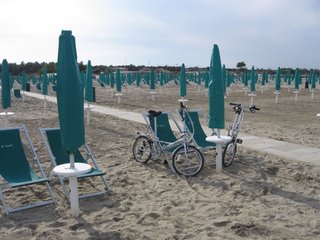 Hinge and Bracket go to the Adriatic
Hinge and Bracket go to the AdriaticTuesday 16th May 2006, Serenissima, Oriago, near Venice
This morning we were amazed to find Modestine's flanks covered in a seething mass of spiders. We have assumed they fell as a nest from the pine trees overhead and burst open on impact.
 A picture for the web
A picture for the webWe have finally made it to the campsite recommended to us by our friend Genevieve from Caen as the perfect location for visiting Venice with a bus every half hour from outside the site. This is actually our second attempt to visit Venice and hopefully will prove more successful than last time. Six years ago we drove as far as Padua only to find Venice flooded and torrential rains that confined us to our hotel room until we gave up and set off towards home, aware that there was no point in hanging on any longer. Even if the rains ceased, by the time the flood waters had receded from Venice we would have needed to have left in order to be back in time for work. It was then that we decided we would buy a camping car when we retired and try again. Our adventures over the past few months are therefore a direct result of our last abortive attempt to see Venice. Better late than never, we are now back, as planned, to try again.
This morning we left Lido di Spina and travelled across country by minor roads that were in far better condition than the potholed main road between Ravenna and Venice. Our route took us right across the flat plains of the Po delta. Once flooded and mosquito ridden it has been drained, much as the polders of Holland, and now provides fertile soil where cereals, fruit and vines are grown. The area is crossed by a network of canals and drainage ditches and many of the roads run along the top of dykes. During the day we crossed not only the main course of the Po, but also several other arms forming its delta. The countryside today was of flat fields of green wheat sprinkled with scarlet poppies. There were also fields of what looked as if it might be rice. We noticed no livestock, just a few storks and herons along the canal sides.
 Wheat and poppies in the Po delta, Comacchio
Wheat and poppies in the Po delta, ComacchioOur first stop was Comacchio, a delightful, bustling little town that we imagine has given us a minor foretaste of what to expect in Venice. The town has several canals cutting through it with cobbled, hump-backed bridges linking the tiny roads. The main form of transport in the town is bicycle. There are hundreds propped everywhere and the main street was bursting with people going about their daily business. Little colour-washed houses lined the canals and nearby on the lagoon huge square nets were lowered to catch fish and eels. Eels are a speciality of the town. Apparently at certain times the canals are full of really huge ones and everybody catches them. Today there were fishermen trying their luck with special nets along the banks of many of the canals. They are on offer on all the restaurant menus and we saw them offered for sale in the picturesque old fish market.
 Trepponti Bridge (1634), spanning five canals in Comacchio
Trepponti Bridge (1634), spanning five canals in Comacchio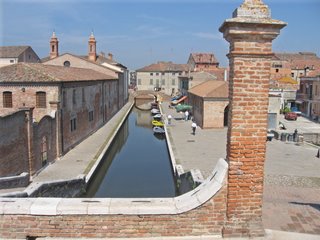 Fish market from Trepponti Bridge, Comacchio
Fish market from Trepponti Bridge, Comacchio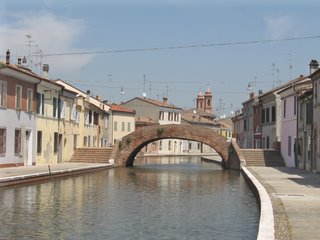 Canal bridge, Comacchio
Canal bridge, Comacchio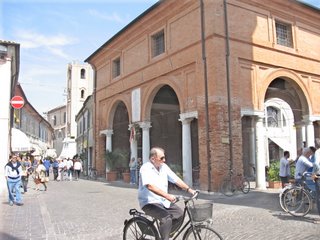 Grain merchants' loggia (1621), Comacchio
Grain merchants' loggia (1621), Comacchio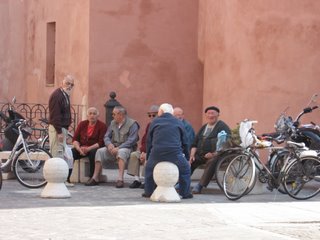 Time For a chat, Comacchio
Time For a chat, Comacchio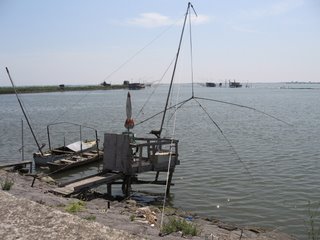 Fishing for eels in the lagoon, Comacchio
Fishing for eels in the lagoon, ComacchioThis was the first time we have seen a brick built baroque cathedral! Even the campanile is in brick. Actually it looked rather attractive and was in keeping with other public buildings in the town.
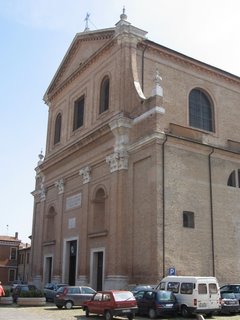 Brick cathedral, Comacchio
Brick cathedral, ComacchioExploring one of the picturesque streets beside a canal we discovered the public library housed in an old palace, the Bellini Palace, with painted ceilings and a collection of vellum-bound books forming part of the local history collection. Here we were offered free internet access by the friendly staff, who were rather amused by Ian's attempt to explain in Italian that we were retired librarians from England. Somehow they thought we were asking them to take our photo! It seems "ritratto" means portrait rather than retired! All delightfully friendly and we now know we are something that sounds like "pensione".
 Large brick building is Bellini Palace with museum and library, Comacchio
Large brick building is Bellini Palace with museum and library, ComacchioThe greatest treasure of the town we discovered by sheer chance on the ground floor of the Bellini Palace. The town hosts the "Museo delle ghise" or man-hole cover museum!! We've always thought there is so much civic pride displayed in the design of drain covers throughout the world and that it would be good to have a museum of such things, but never dreamed that one actually exists!! It has only recently opened and there were still a couple of crates to unpack, donated to the museum by Norway. We were disappointed that England is not represented though Swansea and Dublin are. Amongst the more extravagant covers are examples from Gdansk, Sarajevo, Bergen, Barcelona, Graz, Florence and Salzburg! Each man-hole cover is carefully mounted on it own stand, nicely positioned for the viewer to fully appreciate the ornate design of the ironwork. There must have been a good hundred exhibits and some came with plans from the town councils showing the sewage systems of their cities and providing provenance of the specimen donated. The Norwegian town of Bergen in particular was bursting with pride over the city's coat of arms included when the cover was cast.
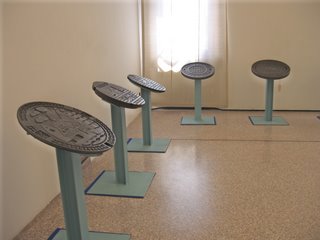 Museo delle ghise, Comacchio
Museo delle ghise, Comacchio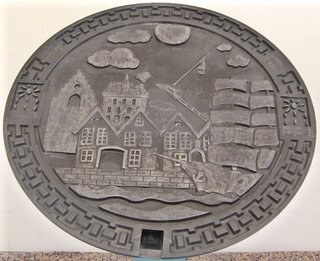 Manhole cover from Bergen, Comacchio
Manhole cover from Bergen, Comacchio Civic pride in Graz, Comacchio
Civic pride in Graz, ComacchioWe were so overcome with delight we went round the exhibition three times and signed our names in the visitors' book with the comment that this was the most fascinating man-hole cover museum we had ever visited! You too can visit this amazing museum at manhole museum It would have been wonderful to have seen Exeter represented here but probably the city council assumed Signor Bottoni, the driving force behind the exhibition, was pulling their corporate leg when he wrote to councils around the world asking them to send him one of their drain covers!
Enough high culture and time to press on towards the frivolity of Venice, still avoiding main roads and exploring the very pleasant countryside of the Po, so very different from the Appenines we crossed a couple of days ago. Around 5pm we reached Serenissima which is a green and pleasant site by the Brenta Canal, lined with Renaissance villas. Most of the other campers here are French and Modestine has attracted the usual attention from them, including someone from Corsica who is sleeping in his car as Corsica is too small for him to own a camper van. He reckons he'd be able to manage a vehicle like Modestine there. After our drive along the Italian Riviera, very similar to Corsica for driving, we've decided against taking her over there.
